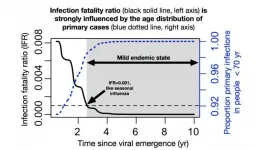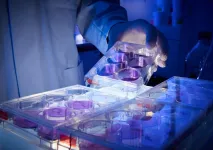Scientists identify "immune cop" that detects SARS-CoV-2
Antiviral protein MDA-5 senses viral replication and governs immune response to SARS-CoV-2
2021-01-12
(Press-News.org) LA JOLLA, CALIF. - Jan 12, 2020 - Scientists at Sanford Burnham Prebys Medical Discovery Institute have identified the sensor in human lungs that detects SARS-CoV-2 and signals that it's time to mount an antiviral response. The study, published today in Cell Reports, provides insights into the molecular basis of severe disease and may enable new strategies for the treatment and prevention of COVID-19.
"Our research has shown that MDA-5 is the immune cop that's tasked to keep an eye out for SARS-CoV-2 and call for back-up," says Sumit Chanda, Ph.D., director of the Immunity and Pathogenesis Program at Sanford Burnham Prebys and senior author of the study. "MDA-5 recognizes replicating viruses in lung cells and activates interferon, the body's own frontline defender against viral invasion. Without a proper interferon response, viral infections can lead to deadly, out-of-control inflammatory reactions."
The new study surveyed 16 viral RNA binding proteins in human lung epithelial cells and identified MDA-5 as the predominant sensor responsible for activating interferon. MDA-5 detects double-stranded viral RNA--a form that the SARS-CoV-2 virus takes when it replicates to spread the infection. Prior to this research, it was known that activating interferon is key to a coordinated immune response to the virus, but the sentinel switch that controls the process was unknown.
"Understanding the biology of a virus and how it is detected is paramount to controlling infection and disease spread," says Chanda. "SARS-CoV-2 appears to disable the innate immune arm of our surveillance system, which, in the case of SARS-CoV-2 is controlled by MDA-5, and prevents the activation of interferon. It's the interferon response that drives the subsequent activation of many genes that exert antiviral activities--and data suggests that we need this activity to control early stages of viral infection and avoid the worst outcomes of COVID-19.
"Whether our bodies can defeat the virus's offensive tactics and activate interferon greatly influences the severity of disease. Past studies have shown that interferon responses are higher in patients with mild-to-moderate cases compared to reduced levels in critically ill patients," adds Chanda.
According to the World Health Organization, as of January 2020 there have been nearly 87 million confirmed cases of COVID-19, including nearly 1.9 million deaths. Although remdesivir and two antibody treatments have received emergency use authorization by the FDA, cases continue to rise. Newly approved vaccines are rapidly being deployed worldwide to end the crisis, however a handful of people are experiencing severe allergic reactions to the shots.
"There is still a tremendous need to develop effective therapies for COVID-19 and to prepare for future outbreaks," says Chanda. "It's possible that patients who become critically ill are deficient in the interferon signaling pathway. This research opens new avenues toward therapies that enhance the MDA-5 signaling to boost interferon levels early in infection to prevent severe disease.
"It also creates opportunities to develop COVID-19 vaccines that include an adjuvant(s) to enhance MDA-5 signaling. These would be formulations that use less 'vaccine' to minimize toxicity and side effects," adds Chanda.
INFORMATION:
The first author of the study is Xin Yin, Ph.D., of Sanford Burnham Prebys and the Chinese Academy of Agricultural Sciences. Additional study authors include Paul D. De Jesus, Kristina Herbert, Laura Martin-Sancho, Yuan Pu, Laura Riva, Chih-Cheng Yang and Sunny Yoh of Sanford Burnham Prebys; Jun Kanamune, Shimpei Gotoh and Yuki Yamamoto of Kyoto University; Kouji Sakai of the National Institute of Infectious Diseases (Tokyo); Judd F. Hultquist of Northwestern University; and Lisa Miorin and Adolfo Garcia-Sastre of the Icahn School of Medicine at Mount Sinai.
The study's DOI is 10.1016/j.celrep.2020.108628.
This work was supported by the following grants to the Sanford Burnham Prebys Medical Discovery Institute: DoD: W81XWH-20-1-0270; DHIPC: U19 AI118610; Fluomics/NOSI: U19 AI135972; R01 AI127302-01A1, as well as generous philanthropic donations from Dinah Ruch and Susan & James Blair. This work was additionally supported by the following grants to Northwestern University Feinberg School of Medicine: a CTSA supplement to NCATS: UL1 TR002389; a CTSA supplement to NUCATS with the generous support of the Dixon family: UL1 TR001422; and a Cancer Center supplement: P30 CA060553. This work was also partly supported by CRIP (Center for Research for Influenza Pathogenesis), an NIAID-supported Center of Excellence for Influenza Research and Surveillance (CEIRS, contract # HHSN272201400008C), by NIAID grant U19AI142733, by NCI grant U54CA260560, by supplements to NIAID grant U19AI135972 and DoD grant W81XWH-20-1-0270, by the Defense Advanced Research Projects Agency (HR0011-19-2-0020), and by the generous support of the JPB Foundation, the Open Philanthropy Project (research grants 2020-215611 and 2020-218415) and anonymous donors to Adolfo Garcia-Satre. Development and implementation of iPSC technology for production of airway epithelial cells was supported by the Incubation Program from the Office of Society-Academia Collaboration for Innovation, Kyoto University.
About Sanford Burnham Prebys Medical Discovery Institute
Sanford Burnham Prebys is a preeminent, independent biomedical research institute dedicated to understanding human biology and disease and advancing scientific discoveries to profoundly impact human health. For more than 40 years, our research has produced breakthroughs in cancer, neuroscience, immunology and children's diseases, and is anchored by our NCI-designated Cancer Center and advanced drug discovery capabilities. For more information, visit us at SBPdiscovery.org or on Facebook at facebook.com/SBPdiscovery and on Twitter @SBPdiscovery.
[Attachments] See images for this press release:

ELSE PRESS RELEASES FROM THIS DATE:
2021-01-12
Family courts are misunderstanding and misusing research around how children form close relationships with their caregivers, say an international group of experts.
Seventy experts from across the globe argue that widespread misunderstandings around attachment research have hampered its accurate implementation, with potentially negative consequences for decisions in family courts.
In response, they have published an international consensus statement in Attachment & Human Development that aims "to counter misinformation and help steer family court applications of attachment theory in a supportive, evidence-based direction on matters related to child protection and custody decisions".
In the statement, the group sets out three principles from attachment research ...
2021-01-12
Philadelphia, January 12, 2021 - A special issue of the Journal of the American College of Radiology (JACR), published by Elsevier, challenges conventional wisdom across the imaging community. This collection of articles, the "Provocative Issue," presents extreme opinions on pressing issues confronting radiologists with the deliberate aim of sparking positive dialog and debate that will lead to innovative solutions to improve patient care and imaging-related outcomes.
The issue is guest-edited by:
Caroline Chung, MD, MSc, Director of Advanced ...
2021-01-12
ATLANTA - JANUARY 12, 2021 - Overall cancer death rates in the United States dropped continuously from 1991 through 2018 for a total decrease of 31%, including a 2.4% decline from 2017 to 2018. The news comes from the American Cancer Society's annual Cancer Statistics, 2021 article, appearing in CA: A Cancer Journal for Clinicians, and its consumer version, Cancer Facts & Figures 2021. This year marks the American Cancer Society's 70th anniversary of reporting this data to inform the nation's fight against cancer.
The report estimates that in the U.S. in 2021, almost 1.9 million (1,898,160) new cancer cases will be diagnosed and 608,570 Americans will die from cancer. ...
2021-01-12
Remarkably well-preserved fossils are helping scientists unravel a mystery about the origins of early animals that puzzled Charles Darwin.
Analysis of the 547 million-year-old remains has enabled researchers to trace the ancestry of some of the world's earliest animals further back than ever before.
Their study has uncovered the first known link between animals that evolved during the so-called Cambrian Explosion some 540 million-years-ago and one of their early ancestors.
Until recently, little was known about the origins of animals that evolved during the Cambrian event because of a lack of well-preserved fossil evidence.
The mysterious origins of animals that evolved at this time - when the diversity ...
2021-01-12
Core technology includes promising bivalent single-domain antibodies simultaneously targeting two surface structures of the viral spike protein.
Lead candidates DIOS-202 and DIOS-203 are engineered for high potency and their potential to avoid the emergence of escape mutants.
DIOS-202 and DIOS-203 entered into accelerated development to initiate clinical studies later this year.
BONN, Germany, January 12, 2021 - DiosCURE SE announced a publication in Science describing its core technology of multivalent single-chain antibodies with a unique molecular mode-of-action to inactivate ...
2021-01-12
While most people are able to eat a normal diet, many of those managing distinct nutritional requirements related to a disease or health condition rely on medical foods. Medical foods help patients meet their nutritional needs, often improving nutritional and health outcomes and quality of life. A recent publication in Current Developments in Nutrition, titled "Medical Foods: Science, Regulation, and Practical Aspects. Summary of a Workshop," shares the historical and regulatory context of medical foods and perspectives on their role in the future.
Medical foods help patients manage their nutritional needs, yet it can be very difficult for patients to have access to them. In August 2019, the Healthcare Nutrition Council (HNC), in partnership with the American Society ...
2021-01-12
What is the endgame for SARS-CoV-2, the virus that is causing worldwide devastation? If it becomes endemic -- circulating in the general population -- and most people are exposed in childhood, SARS-CoV-2 may join the ranks of mild cold-causing coronaviruses that currently circulate in humans, according to a model developed by Emory and Penn State scientists.
The model, published January 12 in Science, draws upon studies of the four common cold coronaviruses and SARS-CoV-1. For those viruses, the term "herd immunity" is incomplete and possibly misleading, says ...
2021-01-12
Antibodies are an important weapon in the immune system's defense against infections. They bind to the surface structures of bacteria or viruses and prevent their replication. One strategy in the fight against disease is therefore to produce effective antibodies in large quantities and inject them into the patients. The outgoing US President Donald Trump probably owes his rapid recovery to this method. However, the antibodies used to treat him have a complex structure, do not penetrate very deeply into the tissue and may cause unwanted complications. Moreover, producing antibodies is difficult and time-consuming. They are therefore probably not suitable for widespread use.
Mass production in yeast or bacteria
"We focus on another group of molecules, the nanobodies," ...
2021-01-12
Researchers at Karolinska Institutet in Sweden have developed, in collaboration with researchers in Germany and the U.S., new small antibodies, also known as nanobodies, which prevent the SARS-CoV-2 coronavirus from entering human cells. The research study, published in Science, shows that a combined nanobody had a particularly good effect - even if the virus mutated. According to the researchers, the nanobodies have the potential to be developed into a treatment for COVID-19.
Specific proteins, spike proteins, on the surface of the SARS-CoV-2 coronavirus help the virus infect host cells. Therefore, antibodies that block the spike proteins and prevent them from binding to the cell can be a way to stop infection.
From the perspective ...
2021-01-12
What will the SARS-CoV-2 outbreak look like ten years from now as it passes from pandemic to endemic, maintained at a constant baseline level in populations without being fueled by outside infections? Data from four endemic human coronaviruses, which circulate globally and cause only mild symptoms, may hold some answers, say Jennie Lavine and colleagues. Their analysis of the immunological and epidemiological data for these viruses helped them develop a model to predict the trajectory of SARS-CoV-2 as it becomes endemic. Most importantly, the authors say, their model incorporates distinct components of immunological protection--susceptibility to reinfection, weakening of the disease after reinfection, and transmissibility of the virus after reinfection--that each wane differently. Lavine ...
LAST 30 PRESS RELEASES:
[Press-News.org] Scientists identify "immune cop" that detects SARS-CoV-2
Antiviral protein MDA-5 senses viral replication and governs immune response to SARS-CoV-2





